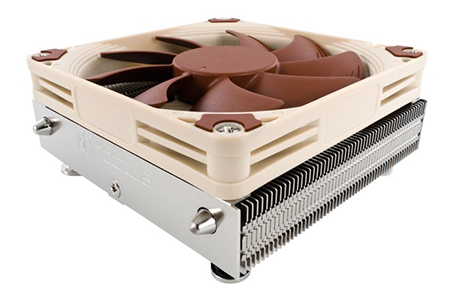The 2.6GHz quad core processor Phenom II X4 910e and the 3.1GHz dual core processor Athlon II X2 255 are latest AMD processor with 65W maximum TDP. Though they may not be performance leader, they do fit nicely into their appropriate niche.
INTRODUCTION
AMD has made a good come back with the Phenom II processor. Despite the fact that the processor is still not able to compete against Intel Core i7 processors, AMD hangs there and gives a good fight against the Core 2 processors. To stay competitive, AMD has launched the first sub $100 quad core processor and released many low power variant quad core processors.
Today, AMD released a few updates to their current line-up. Today’s launch includes the Phenom II X2 555,the fastest dual-core desktop processor running at 3.2GHz with 80W TDP at $99. It will have unlocked multiplier for the overclocking enthusiasts. Three Athlon chips are also released, a quad core X4 635 clocked at 2.9GHz, a triple-core X3 440 at 3.0GHz, and a dual core X2 255 at 3.1GHz. The processors are selling at $119, $84, and $74 respectively. Among the three Athlon processors, the X2 255 has a maximum TDP of 65W while the other two processors have max TDP of 95W.
In addition to the 65W Athlon II X2 255, AMD also releases launched the Phenom II X4 910e that is also with 65W max TDP. This processor is a low power quad core processor running at 2.6GHz clock speed and will be selling at $169. AMD has been releasing low power high performance processors ever since the first Phenom processor. Contrasting the 65W maximum TDP to the 125 watts power that is found on the Phenom II X4 965 BE, a whopping 60 watts less power is consumed.

All of the processors released today are built with 45 nm SOI with Immersion Lithography process by the Global Foundry. They support 3DNow!, SSE, SSE2, SSE3, SSE4a, AMD64, Cool and Quiet, NX bit, and AMD-V. We are not going to repeat all of the details on the Phenom II/Athlon II processors as we had previously released an article discussion these features in detail. One thing we do want to mention is that while the Phenom II X2 555 is manufactured with C3 stepping, all other processors are manufactured with C2 stepping.
AMD also told us that all of these processors will work with their upcoming 800 series motherboards. They are of course compatible with current AMD3 based boards but as always, make sure you have the latest BIOS before install the processor into your board. We tested both AMD CPU’s Athlon Phenom II 910, and the Athlon II X2 255 with an older BIOS on a Gigabyte MA785GMT-UD2H motherboard and we had no issues on getting the computer to boot up.
| CPU Name | Cores | Clock | L2/L3 Cache | HT Bus | Socket | TDP | Price |
| AMD Phenom II X4 965 BE | 4 | 3.4GHz | 2+6MB | 4000MHz | AM3 | 140W | $179 |
| AMD Phenom II X4 955 BE | 4 | 3.2GHz | 2+6MB | 4000MHz | AM3 | 125W | $165 |
| AMD Phenom II X4 945 | 4 | 3.0GHz | 2+6MB | 4000MHz | AM3 | 125W | $159 |
| AMD Phenom II X4 925 | 4 | 2.8GHz | 2+6MB | 4000MHz | AM3 | 95W | $139 |
| AMD Phenom II X4 910e | 4 | 2.6GHz | 2+6MB | 4000MHz | AM3 | 65W | $169 |
| AMD Phenom II X4 905e | 4 | 2.5GHz | 2+6MB | 4000MHz | AM3 | 65W | $175 |
| AMD Phenom II X4 810 | 4 | 2.6GHz | 2+4MB | 4000MHz | AM3 | 95W | $139 |
| AMD Phenom II X3 720BE | 3 | 2.8GHz | 1.5+6MB | 4000MHz | AM3 | 95W | $104 |
| AMD Phenom II X3 710 | 3 | 2.6GHz | 1.5+6MB | 4000MHz | AM3 | 95W | $99 |
| AMD Phenom II X3 705e | 3 | 2.5GHz | 1.5+6MB | 4000MHz | AM3 | 65W | $119 |
| AMD Phenom II X2 555 | 2 | 3.2GHz | 1+6MB | 4000MHz | AM3 | 80W | $99 |
| AMD Phenom II X2 550 | 2 | 3.1GHz | 1+6MB | 4000MHz | AM3 | 80W | $91 |
| AMD Athlon II X4 635 | 4 | 2.9GHz | 2MB | 4000MHz | AM3 | 95W | $120 |
| AMD Athlon II X4 630 | 4 | 2.8GHz | 2MB | 4000MHz | AM3 | 95W | $102 |
| AMD Athlon II X4 620 | 4 | 2.6GHz | 2MB | 4000MHz | AM3 | 95W | $99 |
| AMD Athlon II X3 440 | 3 | 3.0GHz | 1.5MB | 4000MHz | AM3 | 95W | $84 |
| AMD Athlon II X3 435 | 3 | 2.9GHz | 1.5MB | 4000MHz | AM3 | 95W | $75 |
| AMD Athlon II X3 425 | 3 | 2.7GHz | 1.5MB | 4000MHz | AM3 | 95W | $72 |
| AMD Athlon II X2 255 | 2 | 3.1GHz | 2MB | 4000MHz | AM3 | 65W | $75 |
| AMD Athlon II X2 250 | 2 | 3.0GHz | 2MB | 4000MHz | AM3 | 65W | $65 |
| AMD Athlon II X2 245 | 2 | 2.9GHz | 2MB | 4000MHz | AM3 | 65W | $61 |
| AMD Athlon II X2 240 | 2 | 2.8GHz | 2MB | 4000MHz | AM3 | 65W | $53 |
PICTURES AND IMPRESSIONS
We have received two 65W dual core Athlon II X2 255 and the quad core Phenom II X4 910e processors for review today. We are going to put them through our tests to see the performance differences from both 65W processors.
|
Model Number |
X2 255 |
X4 910e |
|---|---|---|
|
Core Frequency:
|
3.1 GHz |
2.6 GHz |
|
Number of Cores:
|
2 |
4 |
|
OPN#
|
ADX255OCK23GQ |
HD910EOCK4DGM |
|
L1 Cache Sizes:
|
64K of L1 instruction and 64K of L1 data cache per core (256KB total L1 per processor) |
64K of L1 instruction and 64K of L1 data cache per core (512KB total L1 per processor) |
|
L2 Cache Sizes:
|
1MB of L2 data cache per core (2MB total L2 per processor) |
512KB of L2 data cache per core (2MB total L2 per processor) |
|
L3 Cache Sizes:
|
None |
6MB (shared) |
|
Memory Controller Type:
|
Integrated 128-bit wide memory controller * |
Integrated 128-bit wide memory controller * |
|
Memory Controller Speed:
|
2.0GHz with Dual Dynamic Power Management |
2.0GHz with Dual Dynamic Power Management |
|
Types of Memory Supported:
|
Support for unregistered DIMMs up to PC2-6400 (DDR2-800MHz) -AND- PC3-8500 (DDR3-1066MHz) |
Support for unregistered DIMMs up to PC2-8500 (DDR2-1066MHz) -AND- PC3-10600 (DDR3-1333MHz) |
|
HyperTransport 3.0 Specification:
|
One 16-bit/16-bit link @ up to 4.0GHz full duplex (2.0GHz x2) |
One 16-bit/16-bit link @ up to 4.0GHz full duplex (2.0GHz x2) |
|
Total Processor-to-System Bandwidth:
|
Up to 33.1GB/s bandwidth Up to 28.8GB/s bandwidth |
Up to 37.3GB/s bandwidth Up to 33.1GB/s bandwidth |
|
Packaging:
|
Socket AM3 938-pin organic micro pin grid array (micro-PGA) |
Socket AM3 938-pin organic micro pin grid array (micro-PGA) |
|
Fab location:
|
GLOBALFOUNDARIES Fab 1 module 1 in Dresden, Germany |
GLOBALFOUNDARIES Fab 1 module 1 in Dresden, Germany |
|
Approximate Die Size:
|
117.5 mm2 |
258 mm2 |
|
Approximate Transistor count:
|
~ 234 million |
~ 758 million |
|
Max Temp:
|
74o Celsius |
71o Celsius |
|
Process Technology:
|
45-nanometer DSL SOI (silicon-on-insulator) technology |
45-nanometer DSL SOI (silicon-on-insulator) technology |
|
Core Voltage:
|
0.85-1.425V |
0.85-1.25V |
| Max TDP: |
65 Watts |
65 Watts |
|
AMD Codename:
|
“Regor” |
“Deneb” |
|
MSRP
|
$74 |
$169 |
*Note: configurable for dual 64-bit channels for simultaneous read/writes
The Athlon X2 carries a retail price of $74, which makes it an ideal processor for HTPC system due to its lower power consumption. Pair it up with the AMD’s 785G chipset and you will be able to get a system setup with less than $300. The CPU is in direct competition against the Intel Pentium E6300 processors which also has a maximum TDP of 65W and clocked at 2.8GHz. While we do not have the Pentium E6300 to compare, we would expect the the performance would be very comparable between the two chips. The advantage of going with the AMD platform is future upgradability as oppose to the aging socket 775 from Intel. Of course, an alternative would be going with the Clarkdale based system with the Intel Pentium G6950 which coincidentally also runs at 2.8GHz but this processor is selling at $20 more than the Athlon X2.
The Phenom II X4 910e is in direct competition against Intel’s Core 2 Quad Q8400 processor. AMD currently has the Phenom X4 905e clocked at 2.5GHz that is in the similar price range, so we would expect the 910e to take over the 905e once the company’s stock runs out.
As you can see that in addition to the numbers of cores differences, the memory supports are also different between the dual and quad core processor. The dual-core processor officially supports DDR2 up to 800MHz and DDR3 up to 1066MHz while the quad core processor supports DDR2 up to 1066MHz and DDR3 up to 1333MHz.
Testing & Methodology
To test the AMD Phenom X4 910e and Athlon II X2 25, we did a fresh load of Windows 7 Ultimate and updated the OS with all the patches and hotfixes we could find for it. We downloaded all the latest drivers and the Latest BIOS from the motherboard manufacture’s site and installed the drivers and flashed the BIOS. Each test was ran a total of 3 times and the average of those three tests reported here.
Hardware Common To All The Test Rigs
- Cooler Master UCP 900W
- Seagate Barracuda 7200.12
- Gigabyte GV-N26SO-896i
- Thermalright SI-128
- DVD/RW ROM
Platform Specific Hardware
- AMD Phenom II X4 910e and Athlon X2 255
- Gigabyte MA785GMT-UD2H
- Kingston HyperX DDR3 1600 (Run at 1066) 4 GB Kit
- Intel Core i7 920
- Gigabyte EX58-UP4P
- Kingston HyperX DDR3 1600 (Run at 1333) 6 GB Kit
- For more information on the Asus M3A78-T you can visit the Asus Website Here
- Intel Q9300 (OC to 3.0GHz)
- Gigabyte EX38-DS4
- OCZ Reaper 1066 (Run at 1066) 4GBKit
- For more information on the Asus M3A78-T you can visit the Asus Website Here
- Phenom 2 X4 810 CPU Equipment
- Asus M3A78-T
- Crucial Ballistix DDR2 1066 4 GB Kit
- For more information on the Asus M3A78-T you can visit the Asus Website Here
- Intel E8400 Equipment
- Gigabyte EP45-Extreme
- Crucial Ballistix DDR2 1066 4 GB Kit
- For more information on the Gigabyte EP45-Extreme you can read our review Here
Test Suite
|
Benchmarks |
|
Excel 2007 |
|
Blender |
|
SiSoft SANDRA XII Professional SP2 |
|
Everest Ultimate Edition v. 5.0 |
|
AutoMKV |
|
WinRar v. 3.71 |
|
POVRay |
|
3DMark Vantage |
Like we mentioned we ran each test 3 times on each CPU then averaged the results, the average is reported here. Some tests we ran more than 3 times and in that case we averaged all the results. If we happened to get a seriously out of range result we discarded to anomalous result and repeated the test.
We kept most of the Synthetic Benchmarks but added a lot of real life benchmarks. This is a trend you will see a lot more of at Bjorn3D. For Winrar we added a workload test consisting of compressing 5 large images, Excel we run calculations on two large spreadsheets, Blender we render a wire frame photo, and AutoMKV we encode another large video file. While synthetic benches are good, real life testing with heavily multi-threaded applications that take advantage of more than 2 cores is long overdue. These applications are heavily multi-threaded and well coded to take advantage of the available cores.
Everest Ultimate

“EVEREST Ultimate Edition is an industry leading system diagnostics and benchmarking solution for enthusiasts PC users, based on the award-winning EVEREST Technology. During system optimizations and tweaking it provides essential system and overclock information, advanced hardware monitoring and diagnostics capabilities to check the effects of the applied settings. CPU, FPU and memory benchmarks are available to measure the actual system performance and compare it to previous states or other systems. Furthermore, complete software, operating system and security information makes EVEREST Ultimate Edition a comprehensive system diagnostics tool that offers a total of 100 pages of information about your PC.”
CPU AES
This integer benchmark measures CPU performance using AES (a.k.a. Rijndael) data encryption. It utilizes Vincent Rijmen, Antoon Bosselaers and Paulo Barreto’s public domain C code in ECB mode.
CPU AES test uses only the basic x86 instructions, the test consumes 48 MB memory, and it is Hyper Threading, multi-processor (SMP) and multi-core (CMP) aware.

The Phenom II X4 910e comes in a tad ahead of the Phenom II X4 810 that is clocked at 100 MHz lower with 273 points higher in the Everest AES test. The Athlon II X2 255 also comes in at 175 points higher than the 3.0GHz Intel E8400.
CPU PhotoWorxx
This integer benchmark performs different common tasks used during digital photo processing.
It performs the following tasks on a very large RGB image:
• Fill
• Flip
• Rotate90R (rotate 90 degrees CW)
• Rotate90L (rotate 90 degrees CCW)
• Random (fill the image with random colored pixels)
• RGB2BW (color to black & white conversion)
• Difference
• Crop
This benchmark stresses the integer arithmetic and multiplication execution units of the CPU and also the memory subsystem.
CPU PhotoWorxx test uses only the basic x86 instructions, and it is Hyper Threading, multi-processor (SMP) and multi-core (CMP) aware.

In the Photoworxx test, none of the AMD processors tested are not able to compete against the E8400. Here we see the Phenom II X4 910e actually comes in a few points lower than the similar clocked X4 810.
Surprisingly,we see the Intel Q9300 actually takes the last place among the CPU tested.
CPU Queen
This simple integer benchmark focuses on the branch prediction capabilities and the misprediction penalties of the CPU. It finds the solutions for the classic “Queens problem” on a 10 by 10 sized chessboard.
CPU Queen test uses integer MMX, SSE2 and SSSE3 optimizations. It consumes less than 1 MB system memory and it is Hyper Threading, multi-processor (SMP) and multi-core (CMP) aware.
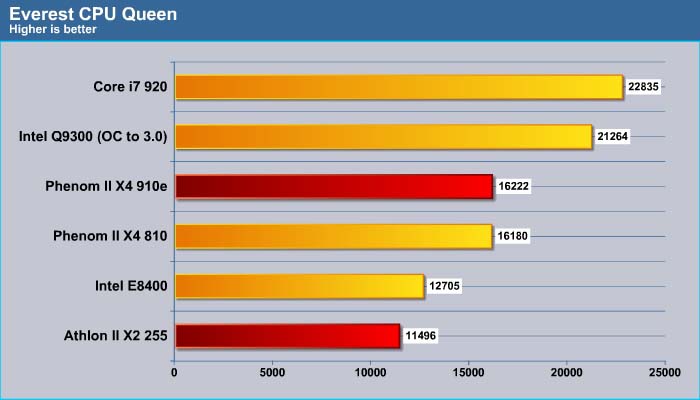
No major surprise here. The Phenom II X4 910e once again comes in a few points higher than the X4 810. The Athlon II X2 255 comes in 10$ lower than the Intel E8400.
CPU ZLib

In Everest’s CPU Zlib we see the slightly higher clockspeed Athlon II X2 255 actually scored 7% higher than the E8400. Once again, there is a little differences among the Phenom X4 810 and 910e.
Everest Memory Suite

The DDR2 memory read speed is simply not able to compete against the DDR3. The Athlon II X2 255 comes in a bit of a surprise with 8241 points, just under the Phenom II X4 810. Oddly enough, the Phenom II X4 910e’s memory read performance is not as good as the X4 810.

Once again, the Athlon II X2 255 shows an excellent memory write performance than any of the AMD quad core processors. It is very possible the lack of L3 cache actually speeds up the memory read and write performance. Here the X4 910e edgest out the X4 810 in the write test.

Again, the X2 255 comes just behind the X4 810. However, the X4 910e once again falls behind the other AMD CPUs.

AMD seems to performs a little better with the memory latency than the Intel counterparts.
Cinebench

“CINEBENCH is a real-world test suite that assesses your computer’s performance capabilities. MAXON CINEBENCH is based on MAXON’s award-winning animation software, CINEMA 4D, which is used extensively by studios and production houses worldwide for 3D content creation. MAXON software has been used in blockbuster movies such as Spider-Man, Star Wars, The Chronicles of Narnia and many more. MAXON CINEBENCH runs several tests on your computer to measure the performance of the main processor and the graphics card under real world circumstances. The benchmark application makes use of up to 16 CPUs or CPU cores and is available for Windows (32-bit and 64-Bit) and Macintosh (PPC and Intel-based). The resulting values among different operating systems are 100% comparable and therefore very useful with regard to purchasing decision-making. It can also be used as a marketing tool for hardware vendors or simply to compare hardware among colleagues or friends.”

The Athlon II X2 255 edgest out the E8400 in the Cinebench test. Unfortunately, the faster clockspeed Q9300 actually performs a tad higher than the X4 910e.
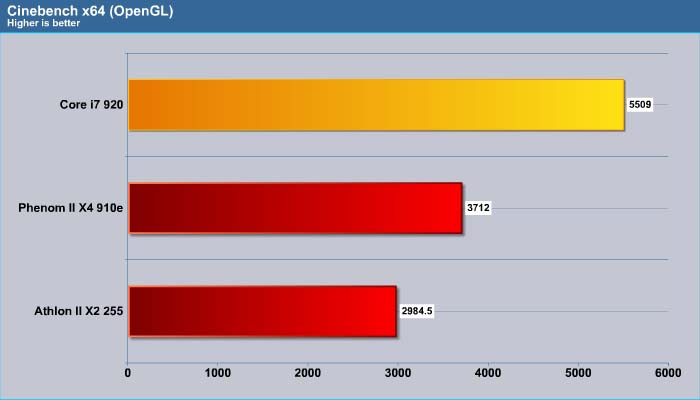
We ran the Cinebench suite six or seven times to confirm this result, we got a slightly higher CPU ratio from the newer Phenom 2 X4 965 and even that small performance increase might be the reason why the lower TDP chip comes out slightly ahead in most of the testing.

WinRar v. 3.71

This module in WinRar generates random data, which contains specially introduced redundancy, increasing the load to both the processor and memory. Data is then passed through RAR compression and decompression algorithms, and the output of the decompression algorithm is compared to the source data. If any differences are found, WinRar then reports “Errors found – Yes” in the command window. WinRar displays a size of processed data and compression speed, current and resulting, in kilobytes per second.

Sisoft Sandra
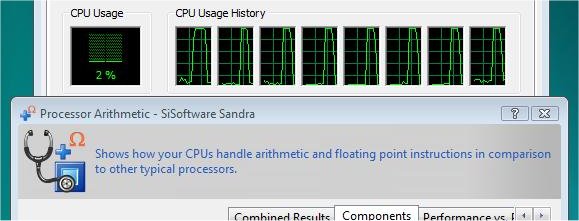
“SiSoftware Sandra (the System ANalyser, Diagnostic and Reporting Assistant) is an information & diagnostic utility. It should provide most of the information (including undocumented) you need to know about your hardware, software and other devices whether hardware or software. It works along the lines of other Windows utilities, however it tries to go beyond them and show you more of what’s really going on. Giving the user the ability to draw comparisons at both a high and low-level. You can get information about the CPU, chipset, video adapter, ports, printers, sound card, memory, network, Windows internals, AGP, PCI, PCI-X, PCIe (PCI Express), database, USB, USB2, 1394/Firewire, etc.”

Sandra shows fairly similar result as what we have observed with the Everest. Here we can see the X2 255 comes behind the E8400. The X4 910e actually has a better result with the Weststone benchmark while lags slightly in the Drystone benchmark when compared against the X4 810.
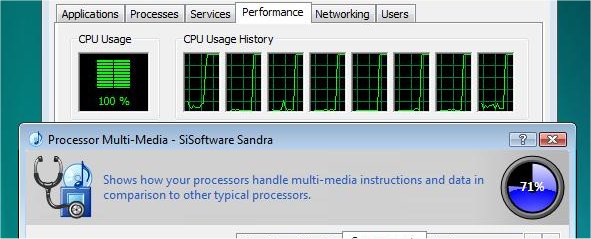

No surprise here again we see the same trends as the processor arithmetic benchmark. Here, however, the X4 910e actually yields a better number in both the float and integer tests. As expected, the Intel system simply has a better result with the multimedia tests but we can see that the quad core AMD processor actually is able to edge out the dual core E8400 slightly.
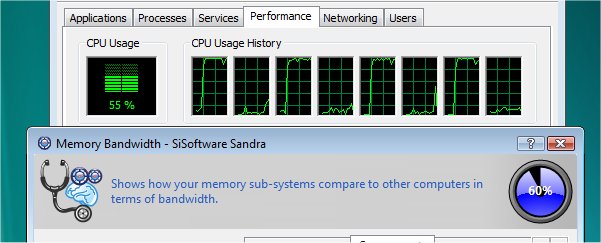
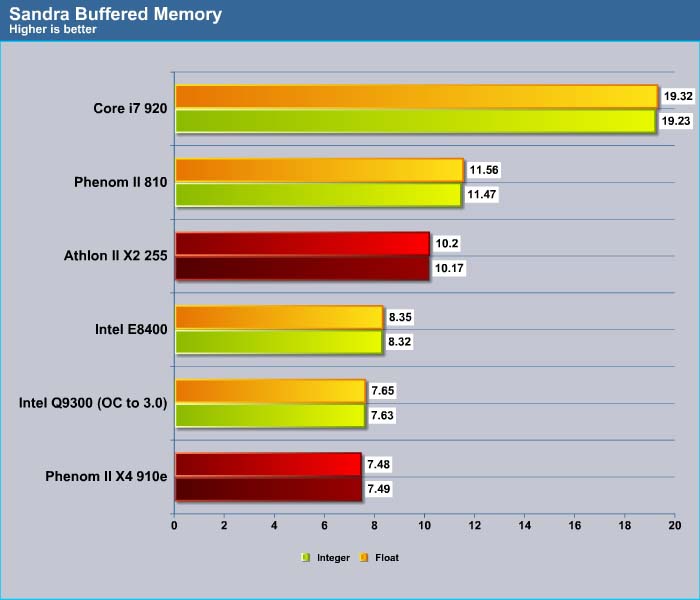
Just as what we have observed, the Phenom X4 910e somehow has a much worse memory performance than other AMD processors. It is possible that future BIOS updates could bring the performance on par with other AMD processors.
POV-Ray 3.7 Beta 25

The Persistence of Vision Ray-Tracer was developed from DKBTrace 2.12 (written by David K. Buck and Aaron A. Collins) by a bunch of people (called the POV-Team) in their spare time. It is a high-quality, totally free tool for creating stunning three-dimensional graphics. It is available in official versions for Windows, Mac OS/Mac OS X and i86 Linux. The POV-Ray package includes detailed instructions on using the ray-tracer and creating scenes. Many stunning scenes are included with POV-Ray so you can start creating images immediately when you get the package. These scenes can be modified so you do not have to start from scratch. In addition to the pre-defined scenes, a large library of pre-defined shapes and materials is provided. You can include these shapes and materials in your own scenes by just including the library file name at the top of your scene file, and by using the shape or material name in your scene. Since this is free software feel free to download this version and try it out on your own.
Some of you might have seen version 3.6 of POV-Ray, the biggest difference between 3.6 and 3.7 Beta 25 is SMP (symmetric multiprocessing) support, which means that POVRay can take advantage of as many cores as your CPU has. On Single vs Dual CPU systems the speed almost doubles.

Microsoft Excel 2007
Monte Carlo Black-Scholes Option Pricing Test
Microsoft Excel is the widely known and most used spreadsheet application for the manipulation and calculation for number crunching. With Excel you can analyze and share information on small scale or the largest scale you can imagine. We’ve seen spreadsheets in every day use that contain literally tens of thousands of numbers and hundreds of equations. Bjorn3D uses two tests in Excel to determine CPU and Motherboard performance.


Although the X4 910e comes in 10 seconds behind the overclocked Q9300, it doubles the time needed to complete the task compare to the dual core X2 255.
Big Number Crunch
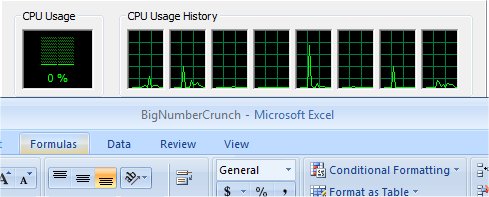
This workload is from a 6.2 MB spreadsheet and executes about 28,000 sets of calculations. It uses the most common calculations in Excel, addition, subtraction, division, rounding and Square Root. It also analyzes statistical functions such as Min, Max Median, and Average. The calculations are done after the spreadsheet with a large data set is updated with new values and must recalculate a large number of data points.
We feel the addition of Excel to our real life benchmarks is an important one. Excel has a huge user base and is one of the most widely used applications worldwide. While Excel will run on almost and modern machine it’s the CPU performance that will determine how fast it runs making it a good application for judging CPU and Motherboard performance.

Similar to what we have seen with the Monte Carlo test, the Big Number Crunch test shows the X4 910e is able to complete the task in half of the time for the X2 255 to complete.
Photodex ProShow Gold 3.2
ProShow Gold allows you to combine videos and photos and music to create slide shows, depending on the end user results can be spectacular. The application allows the end user to share photos and memories with friends in a unique and spectacular way, the different formats supported are, DVD, PC and Web. Still Photos are brought to life by adding motion effects. Supported effects include, Pan, Zoom, and rotate. You can also add captions and over 280 transition effects.


Similarly, the Pro Show Gold also shows that despite running at 2.6GHz clockspeed, the X4 910e is able to complete the job in half of the time for the 3.1GHz X2 255. Although, Intel still dominates the multimedia encoding tasks with the Q9300 able to finish the job at a tad more than half of the time for the X4 910e.
AutoMKV 0.95c
AutoMKV is an application aiming for easy media conversion between various media formats using various third party codecs. With improved internet speed and enhanced computing power, more users are interested in encoding to different media formats for their various multimedia needs. With AutoMKV and x264 codec, a freeware H.264 encoder, users can easily create media files. For more information and to obtain AutoMKV 0.95c and AviSynth* 2.5.7, please visit (http://forum.doom9.org/showthread.php?t=134478). We create a media file using AutoMKV and x264 codec. The input file used in the document is a raw 416 MB 720×480 DV file and the output is a 253MB H.264 media file.
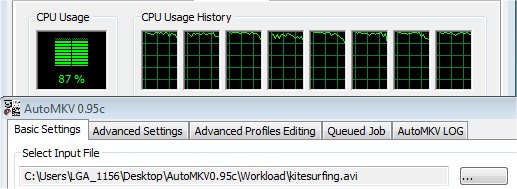

Finally, a test where the current Phenom II actually shines over the older Quad core processor. Here we can see the X4 910e actually is able to finish the job in 1.12 minutes faster than the Intel Q9300 overclocked at 3.0GHz. The X2 255, on the other hand, takes close to 30 minutes to finish the job.
Blender
Blender is a free open source 3D content creation suite that is available for various operating systems. The application is popular among many independent animation studios and game makers. For more information, please visit http://www.blender.org/.
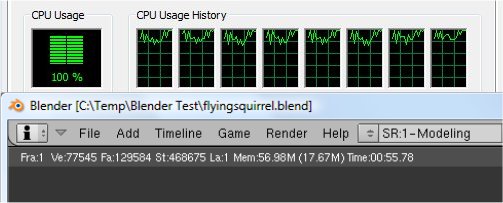
The workload consists of a ~6.9 MB character model of a flying squirrel. Due to time constraints we don’t render the entire image which would be time consuming and rather pointless except to yield larger benchmark numbers. A portion of the image, the right arm is what we render, it’s a large enough portion to show differences in CPU performance, yet small enough that we don’t have to grind through a 45 minute Render waiting for a single result.

Again, the X4 910e is simply not able to compete against the Q9300. It takes 18.41 seconds more to finish the job.
oVERCLOCKING
Athlon II X2 255


I started by raising the FSB to 240 without raise any voltage adjustment and passes Prime95 without any hitch. This yields a healthy 3720 GHz. At 250MHz, the system boots up into BIOS but crashes during Windows loading. Increasing the voltage allows me to boot into Windows without any issue but the system will not pass Prime95 test and crashes.
3.72GHz overclocking result is fairly consistent with what we have observed with most of the AMD’s latest Athlon II processors. It’s likely that with more time and maybe a different board, it’s possible to extract a few extra clockspeed out of the CPU but we feel that 3.7GHz for a $74 processor is not a bad deal.
Phenom II X4 910e
Being that the Phenom II X4 is a quad core processor, we sort of expect it to overclock less than the dual core Athlon II. With the stock voltage of 1.136v, we were able to overclock the processor to 3.1GHz (240MHz FSB).

Knowing that Phenom processors often have voltage of 1.4v, we were curious of the processor’s overclocking ability if we raise the voltage. Thus, we increase the voltage to 1.35v, that is 0.1v higher than AMD’s official maximum voltage so we feel that 1.35v is a safe number to use. At this voltage, we were able to overclock the processor to 3.7GHz without much sweat by simply raising the FSB to 285MHz. Because of the fact that the X4 910e has locked multiplier, to achieve higher clockspeed, it would probably require a board that is capable of 300+ MHz FSB.

We do feel that 3.7GHz from the stock 2.6GHz is nothing to complain about.
Power Consumption
| Feature/Specification | IDLE (WATTS) | LOAD (WATTS) |
|---|---|---|
|
AMD Athlon II X2 255
|
114 |
172 |
|
AMD Phenom II X4 910e (stock voltage)
|
125 |
178 |
|
AMD Phenom II X4 910e (1.35v, 3.7GHz)
|
133 |
221 |
|
Core i7 920
|
149 |
220 |
We were quite surprised to see the power consumption for the Phenom II X4 910e’s power consumption. Despite the fact that we already know that AMD must have hand-picked the processor that will fit the 65W TDP envelope for their power efficient performance quad core, we are not prepared to see its power consumption to be within 10 watts of the dual-core processor. We were quite surprised to see that the processor only consumes 10 watts more under idle and 6 watts higher than the dual core Athlon II X2 255. Even when overclocked to 3.1GHz which is the same speed as the Athlon II X2 255, the processor consumes about the same wattage in both idle and load.
We thought it would be interesting to also compare the power consumption of the overclocked Phenom II X4 910e. As you can see, with 1.35v, the processor consumes 10 watts more under idle and 43 watts more under load.
CONCLUSION
The AMD Phenom II X4 910e is an interesting chip. This processor costs about the same as the faster chip with higher power consumption. The 60 watts of power saved by the Phenom II X4 910e may not seem a lot, it will adds up over the lifespan of the ownership. The power saved will roughly translates to approximately $20~30 saved in an year that itself would pay the extra cost that need to be invested into the chip. Even when it is overclocked to 3.1GHz, the chip still consumes roughly the same wattage as it is running at 2.6GHz. It also has a potential to overclock to faster speed with higher voltage if you don’t care about the power efficiency.
Something we did not mention about the chip is that it runs really cool. So, we think that this is an excellent chip for HTPC and multi-tasking environment due to its power consumption and good general performance.
The Athlon II X2 255 does not gear much excitement but the chip is at least able to compete with the Intel E8400 in most areas with the exception of the multimedia tasks. The chip faces a stiff competition against the Intel Core i3 but then again, the Core i3 are a tad more expensive than the X2 255. The cheapest Core i3 that we can find online is Pentium G6950 that is selling at $96.99, $20 more than the X2 255. When we fact in the motherboard costs, the Core i3 system will come in generally $30~$40 more than the Athlon based system. The Athlon X2 255’s performance is pretty good and it overclocks fairly easily to 3.7GHz without much adjustments. We think this is clearly a good winner for budget system.
Ultimately, we think today’s AMD launch will not generate much excitements among enthusiasts but AMD seem to find a nice niche for multi-takers with power saving mind with their Phenom II X4 910e. In addition, the Athlon II X2 255 would fits nicely in a budget system where it will do almost all day to day tasks without much issue.
| OUR VERDICT: AMD Phenom II X4 910e |
||||||||||||||||||
|
||||||||||||||||||
|
Summary: The Phenom II X4 910e is an excellent choice for the multi-tasker and HTPC users who need a powerful quad core processor while keeping the power consumption low. |
| OUR VERDICT: AMD Athlon II X2 255 |
||||||||||||||||||
|
||||||||||||||||||
|
Summary: The Athlon II X2 255 is an excellent choice for budget system with it balanced cost and performance ratio. |
| CPU Name | Cores | Clock | L2/L3 Cache | HT Bus | Socket | TDP | Price |
| AMD Phenom II X4 965 BE | 4 | 3.4GHz | 2+6MB | 4000MHz | AM3 | 140W | $179 |
| AMD Phenom II X4 955 BE | 4 | 3.2GHz | 2+6MB | 4000MHz | AM3 | 125W | $165 |
| AMD Phenom II X4 945 | 4 | 3.0GHz | 2+6MB | 4000MHz | AM3 | 125W | $159 |
| AMD Phenom II X4 925 | 4 | 2.8GHz | 2+6MB | 4000MHz | AM3 | 95W | $139 |
| AMD Phenom II X4 910e | 4 | 2.6GHz | 2+6MB | 4000MHz | AM3 | 65W | $169 |
| AMD Phenom II X4 905e | 4 | 2.5GHz | 2+6MB | 4000MHz | AM3 | 65W | $175 |
| AMD Phenom II X4 810 | 4 | 2.6GHz | 2+4MB | 4000MHz | AM3 | 95W | $139 |
| AMD Phenom II X3 720BE | 3 | 2.8GHz | 1.5+6MB | 4000MHz | AM3 | 95W | $104 |
| AMD Phenom II X3 710 | 3 | 2.6GHz | 1.5+6MB | 4000MHz | AM3 | 95W | $99 |
| AMD Phenom II X3 705e | 3 | 2.5GHz | 1.5+6MB | 4000MHz | AM3 | 65W | $119 |
| AMD Phenom II X2 555 | 2 | 3.2GHz | 1+6MB | 4000MHz | AM3 | 80W | $99 |
| AMD Phenom II X2 550 | 2 | 3.1GHz | 1+6MB | 4000MHz | AM3 | 80W | $91 |
| AMD Athlon II X4 635 | 4 | 2.9GHz | 2MB | 4000MHz | AM3 | 95W | $120 |
| AMD Athlon II X4 630 | 4 | 2.8GHz | 2MB | 4000MHz | AM3 | 95W | $102 |
| AMD Athlon II X4 620 | 4 | 2.6GHz | 2MB | 4000MHz | AM3 | 95W | $99 |
| AMD Athlon II X3 440 | 3 | 3.0GHz | 1.5MB | 4000MHz | AM3 | 95W | $84 |
| AMD Athlon II X3 435 | 3 | 2.9GHz | 1.5MB | 4000MHz | AM3 | 95W | $75 |
| AMD Athlon II X3 425 | 3 | 2.7GHz | 1.5MB | 4000MHz | AM3 | 95W | $72 |
| AMD Athlon II X2 255 | 2 | 3.1GHz | 2MB | 4000MHz | AM3 | 65W | $75 |
| AMD Athlon II X2 250 | 2 | 3.0GHz | 2MB | 4000MHz | AM3 | 65W | $65 |
| AMD Athlon II X2 245 | 2 | 2.9GHz | 2MB | 4000MHz | AM3 | 65W | $61 |
| AMD Athlon II X2 240 | 2 | 2.8GHz | 2MB | 4000MHz | AM3 | 65W | $53 |
 Bjorn3D.com Bjorn3d.com – Satisfying Your Daily Tech Cravings Since 1996
Bjorn3D.com Bjorn3d.com – Satisfying Your Daily Tech Cravings Since 1996






